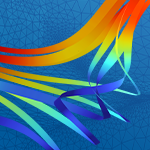Sehen Sie, wie die Multiphysik-Simulation in verschiedenen Branchen eingesetzt wird
Multiphysik-Modellierung und -Simulation treiben Innovationen in Industrie und Wissenschaft voran – wie die zahlreichen Anwendungsbeispiele zeigen, die jedes Jahr in den Fachbeiträgen und Postern von Ingenieuren, Forschern und Wissenschaftlern auf der COMSOL Conference vorgestellt werden. Lassen Sie sich von den unten aufgeführten aktuellen Beiträgen inspirieren oder nutzen Sie die Schnellsuche, um eine bestimmte Präsentation zu finden oder nach Anwendungsbereich oder Konferenzjahr/-ort zu filtern.
Sehen Sie sich die Kollektion für die COMSOL Conference 2024 an
Droplet flow at microscopic scale is often used to enhance many pharmaceuticals and industrial processes (i.e. liquid–liquid micro-extraction, nanoparticle synthesis, slow reactions in microfluidic devices, etc.). In all these processes, the mass transfer rate, at the interface between ... Mehr lesen
In the medium term, gas hydrate reservoirs in the subsea sediment are intended as deposits for carbon dioxide (CO2) from fossil fuel consumption. This idea is supported by the fact, that CO2 hydrates are more stable than methane hydrates at certain conditions. The potential of producing ... Mehr lesen
A COMSOL Multiphysics® model is used to optimise the slot geometry of a large air-gap linear synchronous motor. Fixed dimensions are used for the pole pitch, stator depth, stator width and air-gap, since the amount of available space is usually limited. A parametric sweep of the slot ... Mehr lesen
In ground-coupled heat pumps (GCHPs) the coupling between heat pumps and ground occurs by means of ground heat exchangers, that can be installed vertically inside boreholes (BHEs) or horizontally (HGHEs). In the horizontal installation, the heat exchangers are placed in shallow trenches ... Mehr lesen
The approach of this project is Modeling a Coriolis Mass Flow-meter (CMF) bases on a Fluid-Structure Interaction (FSI) device. The "Coriolis mass flow-meter sensor" is modeled using COMSOL Multiphisics® simulation, the Acoustic-Shell Interaction physics interface and coupled by FSI ... Mehr lesen
The high temperature measurement of thermal conductivity is vital for predicting nuclear fuel performance both during reactor operation and accident conditions. The proposed method uses experimental thermograms obtained via high temperature laser-flash heating of a disc-shaped sample in ... Mehr lesen
The Atlantis massif is a domal submarine seamount close to the mid-Atlantic Ridge at 30 °N. Close to the crest of the Massif, the Lost City hydrothermal field (LCHF) has been active for at least 120,000 years, venting fluids with a temperature of 40-90 °C. 5 km north of Lost City, a ... Mehr lesen
The Life+ GreenWoolF project is aimed at demonstrating that green hydrolysis with superheated water is an effective way to convert wool wastes into organic nitrogen fertilizers. The core of the process is represented by the reaction tank (Figure 1) in which the hydrolyses reaction takes ... Mehr lesen
Manual wheelchair users suffer shoulder pain and injury in the long term because of unconscious overuse. The ‘SENSEWHEEL’, which interposes three identical load cells between pushrim and rear wheel, measures the three components of pushing force Fx, Fy and Fz, and axial torque Tx ... Mehr lesen
Capacitive deionization (CDI) is a desalination technology which is based on the storage of ions in the electrical double layer of a pair of oppositely polarized porous carbon electrodes, which are usually assembled using activated carbon particles (Figure 1). It is efficiently deployed ... Mehr lesen








